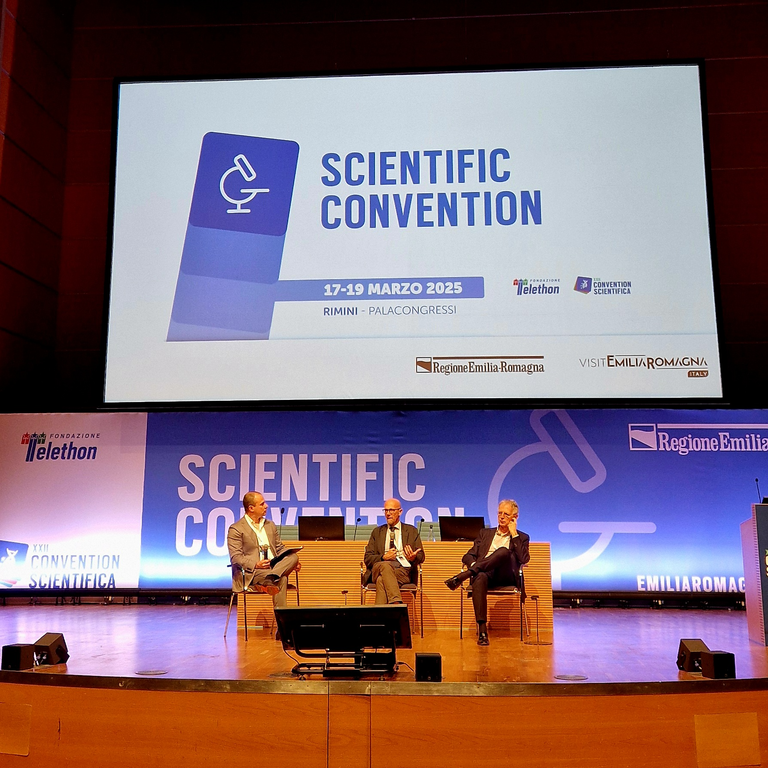Balancing Safety and Efficacy in Gene Therapy: A Roundtable Discussion with Celeste Scotti, Alberto Auricchio, and Luigi Naldini

The Fondazione Telethon Convention hosted a compelling roundtable featuring Celeste Scotti (R&D Director), Alberto Auricchio (Director of TIGEM), and Luigi Naldini (Director of TIGET). The discussion centered on the evolving landscape of gene therapy, exploring how to balance safety and efficacy while leveraging gene transfer and genome editing as platform-based approaches to accelerate therapeutic development.
Advancements in Gene Therapy: A More Defined Clinical Picture
Over the years, gene therapy has made significant strides, leading to a better clinical understanding of safety and efficacy. With more refined tools and deeper investigative capabilities, researchers can now assess gene therapy interventions with unprecedented precision.
Understanding potential genotoxicity has become a crucial area of investigation, as new sequencing techniques allow scientists to map alterations at target sites more accurately. However, long-term safety monitoring in clinical settings remains essential.
Overcoming the Challenges in Gene Therapy
Both AAV (adeno-associated virus) and lentiviral vectors have intrinsic challenges. AAV-based gene therapies face immunogenicity issues, as 40% of individuals have pre-existing antibodies that can neutralize the vector before it reaches its target. On the other hand, lentiviral vectors integrate into the host genome, raising concerns about potential insertional mutagenesis.
New advancements are actively overcoming these challenges: AAV vectors remain episomal, meaning that the therapeutic transgene expression may be transient. However, genome editing approaches can provide persistent gene expression, addressing this limitation. Lentiviral integration, once seen as a challenge, can now be controlled and leveraged for long-term expression when needed. Immunogenicity issues are being tackled with innovative strategies, such as transient IgG depletion to improve AAV treatment accessibility. Rather than debating which technology is superior, we now have a portfolio of gene therapy approaches, each suited to different disease contexts. The key is to develop these technologies rapidly to create new therapeutic tools and ensure their accessibility for patients.
The Emerging Role of Non-Viral Delivery Strategies
Non-viral delivery systems, particularly lipid nanoparticles (LNPs), have been available for decades, but they gained significant attention after the COVID-19 pandemic, which showcased their efficacy, scalability, and safety in delivering mRNA-based vaccines. This renewed interest has accelerated their application in gene therapy, positioning them as a powerful tool not only for mRNA delivery but also for genome editing approaches.
LNPs are now being used to transiently deliver nucleases required for genome editing, such as CRISPR-Cas9, allowing precise genetic modifications without the risk of permanent vector integration. This transient expression enhances safety, reducing off-target effects and long-term genomic alterations, making LNPs a promising alternative to viral vectors in certain applications.
In particular, LNPs have shown high efficiency in in vivo delivery, especially for liver-targeted therapies, where they can efficiently transport therapeutic payloads to hepatocytes. As research advances, non-viral strategies are expected to play an increasingly prominent role in the gene therapy landscape, offering a flexible and potentially safer alternative to traditional viral-based approaches.
The integration of LNP-based genome editing technologies into clinical applications could significantly improve therapeutic possibilities, enabling safer, transient, and high controlled gene modifications.
As the field progresses, non-viral systems will become a key component in the expanding portfolio of gene therapy tools, helping to tailor treatments to specific disease needs.
Gene Therapy as a Platform: Rethinking Regulatory Approaches
One of the critical topics discussed was the sustainability of gene therapy development. Despite decades of progress, regulatory agencies still classify gene therapies as traditional drugs, applying the same frameworks used for conventional pharmaceuticals. However, gene therapies are fundamentally more complex and require dedicated regulatory pathways that address their unique characteristics, from development to safety assessment and market access.
A key aspect of streamlining gene therapy regulation is recognizing that many of these therapies share the same vector backbones. This raises a crucial question:
If we are using the same vector backbone, why should we repeat extensive safety and stability studies for every new application?
By adopting a platform-based regulatory framework, regulators could reduce unnecessary repetition of tests, cutting development time and costs without compromising safety. This approach would allow gene therapy developers to leverage existing data, accelerating the approval process while maintaining high safety standards.
Ensuring Sustainability in Gene Therapy
- Scaling up production by expanding the number of approved products, increasing efficiency and driving down costs.
- Building an integrated value chain by fostering collaborations between biotech companies, manufacturers, and regulators to create a more efficient and cost-effective ecosystem.
- Optimizing clinical pathways by reducing redundant testing and leveraging real-world evidence to support approvals and post-market surveillance.
- By combining regulatory innovation with strategic collaboration and industrial scaling, gene therapy can transition from a highly specialized treatment to a widely accessible therapeutic option, ensuring that life-changing therapies reach patients in need faster and at a lower cost.
Conclusion: Shaping the Future of Gene Therapy
The roundtable discussion underscored the immense potential of gene therapy, from refining genome editing and vector design to tackling immunological barriers and developing non-viral strategies. As the field advances, researchers and industry leaders must collaborate with regulators to create a sustainable framework that balances innovation, safety, and accessibility.
Beyond scientific breakthroughs, the future of gene therapy depends on strategic collaboration, regulatory innovation, and the development of an ecosystem that ensures these transformative treatments reach those who need them most.
